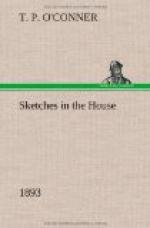[Sidenote: The out-manoeuvred Tories.]
I think I have now said enough to explain what I am going to relate. Mr. Gladstone explained his proposal; which briefly was, that in order to get on with Home Rule it was necessary to take the time of private members. As will have been seen, the meaning of this would have been to have swept away at once all the private motions in which members were interested. When the motion came to be discussed, there was a very curious phenomenon. Everybody had been reading in the morning papers the chorus of disapproval in which the Tory press had been denouncing the leadership of the Tory party, liberals had been repeating to each other with delight the verdict of the chief Tory organ—the Standard newspaper—that the Tory party had been out-manoeuvred and beaten at every point in the struggle, and that the portentous promises of the recess had been utterly baffled by the superior judgment, the better concerted tactics, and, above all, by the unexpected solidity and cohesion of the Liberal party.
[Sidenote: Organized for obstruction.]
That all this had produced its effect on the Tory party as well was soon evident. An old campaigner in the House of Commons can soon tell when a party has been organized for the purpose of Obstruction. There is a feverishness; there are ample notes; there is a rising of many members at the same time when the moment comes to catch the Speaker’s eye. Other indications presented themselves. Mr. Seton-Karr is, personally, one of the kindliest of men—cheery, good-natured, full of the easy give-and-take of political struggle; but even he himself would not claim to be a Parliamentary orator. But on February 27th, he, as much as everybody else, must have been surprised to find that his utterances, which, in truth, were stumbling enough, should at every point be punctuated by a deep bellow of cheers such as might have delighted the most trained and the most accomplished orators in the House. The House itself was at first taken aback by this outburst of deep-throated and raucous cheers, and after it had sufficiently recovered from its surprise discovered that it all came from one bench—the front bench below the gangway. On this bench there were gathered together a number of the younger members of the Tory party.
[Sidenote: The claque in Parliament.]




